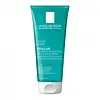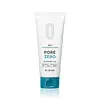La Roche-Posay Effaclar Micro-Peeling Purifying Gel Versus Be The Skin BHA+ Pore Zero Cleansing Foam
What's inside
What's inside
 Key Ingredients
Key Ingredients

 Benefits
Benefits

 Concerns
Concerns

 Ingredients Side-by-side
Ingredients Side-by-side

Water
Skin ConditioningSodium Laureth Sulfate
CleansingDecyl Glucoside
CleansingGlycerin
HumectantSodium Chloride
MaskingCoco-Betaine
CleansingSalicylic Acid
MaskingPEG-150 Pentaerythrityl Tetrastearate
EmulsifyingPEG-6 Caprylic/Capric Glycerides
EmulsifyingZinc Gluconate
Skin ConditioningSodium Hydroxide
BufferingCapryloyl Salicylic Acid
ExfoliatingTetrasodium EDTA
Citric Acid
BufferingMenthol
MaskingPolyquaternium-47
Skin ConditioningHexylene Glycol
EmulsifyingSodium Benzoate
MaskingWater, Sodium Laureth Sulfate, Decyl Glucoside, Glycerin, Sodium Chloride, Coco-Betaine, Salicylic Acid, PEG-150 Pentaerythrityl Tetrastearate, PEG-6 Caprylic/Capric Glycerides, Zinc Gluconate, Sodium Hydroxide, Capryloyl Salicylic Acid, Tetrasodium EDTA, Citric Acid, Menthol, Polyquaternium-47, Hexylene Glycol, Sodium Benzoate
Water
Skin ConditioningMyristic Acid
CleansingGlycerin
HumectantButylene Glycol
HumectantGlycol Distearate
EmollientPotassium Hydroxide
BufferingTea-Lauryl Sulfate
CleansingStearic Acid
CleansingLauryl Betaine
CleansingGlyceryl Stearate
EmollientPEG-100 Stearate
Lauric Acid
CleansingBeeswax
Emulsion StabilisingLauryl Glucoside
CleansingButyrospermum Parkii Butter
Skin ConditioningSalix Alba Bark Water
Astringent1,2-Hexanediol
Skin ConditioningCeteareth-60 Myristyl Glycol
EmulsifyingCaprylyl Glycol
EmollientPolyquaternium-7
Pentylene Glycol
Skin ConditioningPropanediol
SolventSalix Alba Bark Extract
AstringentSalicylic Acid
MaskingTromethamine
BufferingGlycolipids
Skin ConditioningHydroxyethylcellulose
Emulsion StabilisingMethylpropanediol
SolventPrunus Davidiana Extract
AntioxidantSalvia Hispanica Seed Extract
EmollientVitis Vinifera Fruit Extract
Skin ConditioningPyrus Malus Fruit Extract
Skin ConditioningPrunus Mume Fruit Extract
HumectantCarica Papaya Fruit Extract
Skin ConditioningSilkworm Cocoon Extract
HumectantSodium Bisulfite
AntioxidantDisodium EDTA
Sodium Benzoate
MaskingParfum
MaskingWater, Myristic Acid, Glycerin, Butylene Glycol, Glycol Distearate, Potassium Hydroxide, Tea-Lauryl Sulfate, Stearic Acid, Lauryl Betaine, Glyceryl Stearate, PEG-100 Stearate, Lauric Acid, Beeswax, Lauryl Glucoside, Butyrospermum Parkii Butter, Salix Alba Bark Water, 1,2-Hexanediol, Ceteareth-60 Myristyl Glycol, Caprylyl Glycol, Polyquaternium-7, Pentylene Glycol, Propanediol, Salix Alba Bark Extract, Salicylic Acid, Tromethamine, Glycolipids, Hydroxyethylcellulose, Methylpropanediol, Prunus Davidiana Extract, Salvia Hispanica Seed Extract, Vitis Vinifera Fruit Extract, Pyrus Malus Fruit Extract, Prunus Mume Fruit Extract, Carica Papaya Fruit Extract, Silkworm Cocoon Extract, Sodium Bisulfite, Disodium EDTA, Sodium Benzoate, Parfum
 Reviews
Reviews

Ingredients Explained
These ingredients are found in both products.
Ingredients higher up in an ingredient list are typically present in a larger amount.
Glycerin is already naturally found in your skin. It helps moisturize and protect your skin.
A study from 2016 found glycerin to be more effective as a humectant than AHAs and hyaluronic acid.
As a humectant, it helps the skin stay hydrated by pulling moisture to your skin. The low molecular weight of glycerin allows it to pull moisture into the deeper layers of your skin.
Hydrated skin improves your skin barrier; Your skin barrier helps protect against irritants and bacteria.
Glycerin has also been found to have antimicrobial and antiviral properties. Due to these properties, glycerin is often used in wound and burn treatments.
In cosmetics, glycerin is usually derived from plants such as soybean or palm. However, it can also be sourced from animals, such as tallow or animal fat.
This ingredient is organic, colorless, odorless, and non-toxic.
Glycerin is the name for this ingredient in American English. British English uses Glycerol/Glycerine.
Learn more about GlycerinSalicylic Acid (also known as beta hydroxy acid or BHA) is a well-known ingredient for treating skin that struggles with acne and clogged pores. It exfoliates both the skin's surface and deep within the pores to help clear out buildup, control oil, and reduce inflammation.
Unlike AHAs (alpha hydroxy acids), salicylic acid is oil-soluble. This allows it to penetrate into pores which makes it especially effective for treating blackheads and preventing future breakouts.
Salicylic acid is also known for its soothing properties. It has a similar structure to aspirin and can calm inflamed or irritated skin, making it a good option for acne-prone skin that is also sensitive.
Concentrations of 0.5-2% are recognized by the U.S. FDA as an over-the-counter topical acne product.
It can cause irritation and/or dryness if one's skin already has a compromised moisture barrier, so it's best to focus on repairing that before introducing this ingredient into your routine.
While salicylic acid does not increase sun sensitivity, it’s still important to wear sunscreen daily to protect your skin.
If you are looking for the ingredient called BHA or Butylated Hydroxyanisole, click here.
Learn more about Salicylic AcidSodium Benzoate is a preservative. It's used in both cosmetic and food products to inhibit the growth of mold and bacteria. It is typically produced synthetically.
Both the US FDA and EU Health Committee have approved the use of sodium benzoate. In the US, levels of 0.1% (of the total product) are allowed.
Sodium benzoate works as a preservative by inhibiting the growth of bacteria inside of cells. It prevents the cell from fermenting a type of sugar using an enzyme called phosphofructokinase.
It is the salt of benzoic acid. Foods containing sodium benzoate include soda, salad dressings, condiments, fruit juices, wines, and snack foods.
Studies for using ascorbic acid and sodium benzoate in cosmetics are lacking, especially in skincare routines with multiple steps.
We always recommend speaking with a professional, such as a dermatologist, if you have any concerns.
Learn more about Sodium BenzoateWater. It's the most common cosmetic ingredient of all. You'll usually see it at the top of ingredient lists, meaning that it makes up the largest part of the product.
So why is it so popular? Water most often acts as a solvent - this means that it helps dissolve other ingredients into the formulation.
You'll also recognize water as that liquid we all need to stay alive. If you see this, drink a glass of water. Stay hydrated!
Learn more about Water